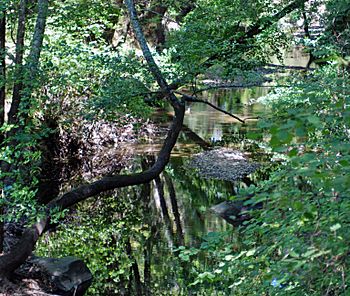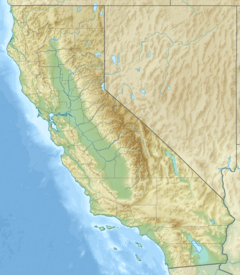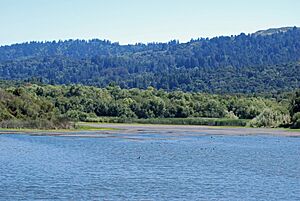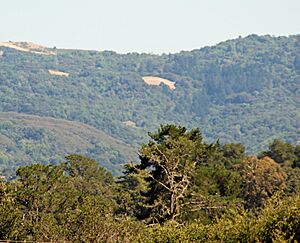Corte Madera Creek (San Mateo County) facts for kids
Quick facts for kids Corte Madera Creek |
|
|---|---|

Corte Madera Creek just below Searsville Dam July 22, 2011
|
|
|
Location of the mouth in California
|
|
| Other name(s) | Corte De Madera Creek |
| Country | United States |
| State | California |
| Region | Southeastern San Mateo County |
| City | Portola Valley, California |
| Physical characteristics | |
| Main source | Russian Ridge Open Space Preserve. 1,950 ft (590 m) 37°19′26″N 122°11′24″W / 37.32389°N 122.19000°W |
| River mouth | Searsville Lake Portola Valley, California 351 ft (107 m) 37°24′03″N 122°14′18″W / 37.40083°N 122.23833°W |
| Basin features | |
| Tributaries |
|
Corte Madera Creek is a creek in California. Its name comes from Spanish language and means "a place where wood is cut." This creek is about 7.3-mile-long (11.7 km). It flows north-northwest into Searsville Dam and then joins with Bear Creek. Together, they form San Francisquito Creek.
Contents
History of the Creek
Historically, Corte Madera Creek flowed through two old land grants. These grants were called Rancho Cañada del Corte de Madera and Rancho Corte de Madera.
Wildlife in the Creek
Corte Madera Creek was once home to Steelhead trout. These fish are special because they swim from the ocean up into freshwater streams to lay their eggs. This is called being "anadromous." However, since 1890, the Searsville Dam has blocked their path.
Even though steelhead can't swim past the dam, their relatives, the rainbow trout, still live in the creek above the dam.
Fish and Other Animals
In 1996, scientists studied the area around Searsville Lake and Corte Madera Creek. They found that many native fish used to live there. These included:
- Steelhead/coastal rainbow trout
- Sculpin
- California roach
- Hitch
- Speckled dace
- Sacramento sucker
- Pacific lamprey
- Possibly three-spined stickleback, Sacramento pikeminnow, Sacramento blackfish, and coho salmon.
Today, only Sacramento sucker and rainbow trout are commonly seen. The dam changed the habitat, and many non-native fish now live in Searsville Reservoir. These non-native fish, like sunfish and black bass, eat the native fish.
Frogs and Other Creatures
Scientists also found that federally threatened California red-legged frogs live in the creek below the dam. But they don't live above the dam. This is likely because of the non-native fish and American bullfrogs that live in the reservoir. These non-native animals prey on the frogs.
What Happens Below the Dam?
In 2013, the pool of water below Searsville Dam was drained for a safety check. Scientists found some native fish there, including two steelhead trout, 26 California roach, and 22 Sacramento suckers.
However, they found many more non-native animals:
- Over 1,500 non-native fish, including more than 500 sunfish (like green sunfish and bluegill), two bullhead catfish, and over 1,000 mosquitofish.
- 500 bullfrogs.
- 150 Louisiana red swamp crayfish.
This shows how many non-native species live in the reservoir and can spread downstream.
Helping the Fish
In 1991, an adult steelhead was seen trying to jump over Searsville Dam. In 2002, a survey found that some bridges on Corte Madera Creek also blocked fish from swimming upstream. In 2014, Searsville Dam was identified as a top priority to help native fish by improving water flow.
Unfortunately, people have illegally fished for rainbow trout in the creek. This has harmed the remaining native trout. Also, some private ponds have non-native fish like Smallmouth Bass and Bluegill. These fish can escape during floods and threaten young native trout and their eggs.
Where the Creek Flows
Corte Madera Creek starts near Borel Hill in the Coal Creek Open Space Preserve. It flows northwest along the San Andreas Fault. Along the way, it picks up water from several smaller creeks. These include Coal Creek, Rengstorff Gulch, Damiani Creek, Jones Gulch, and Hamms Gulch. All these creeks drain from the northeastern side of the Santa Cruz Mountains.
The creek then reaches Portola Valley. Before it gets to Searsville Reservoir, it enters a large wetland area. Several other creeks join here, such as Westbridge Creek, Sausal Creek, Dennis Martin Creek, and Alambique Creek.
Historically, these creeks flowed into natural wetlands. But when Searsville Dam was built, this wetland area was submerged and filled with sediment.
Below Searsville Dam, Corte Madera Creek joins with Bear Creek to form San Francisquito Creek.




